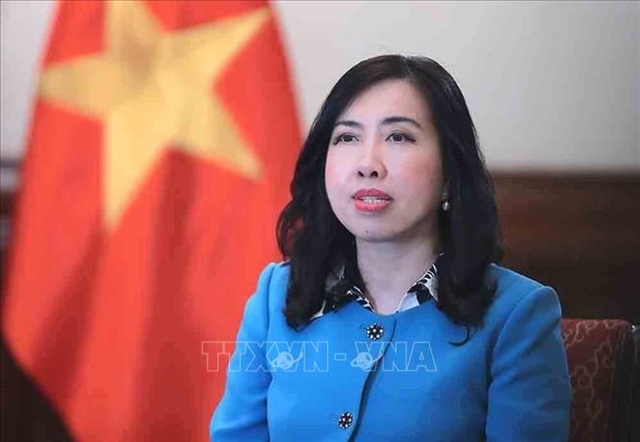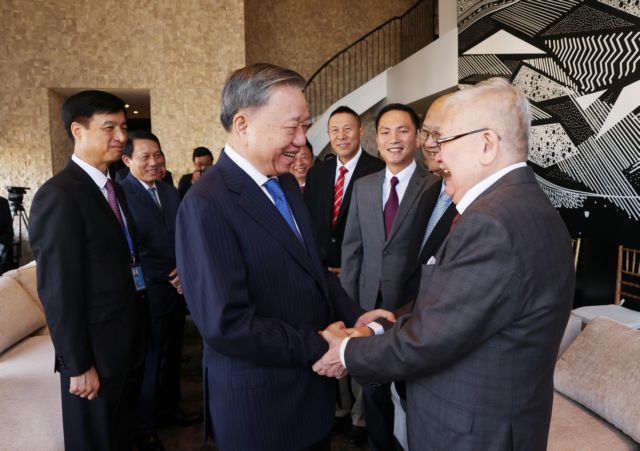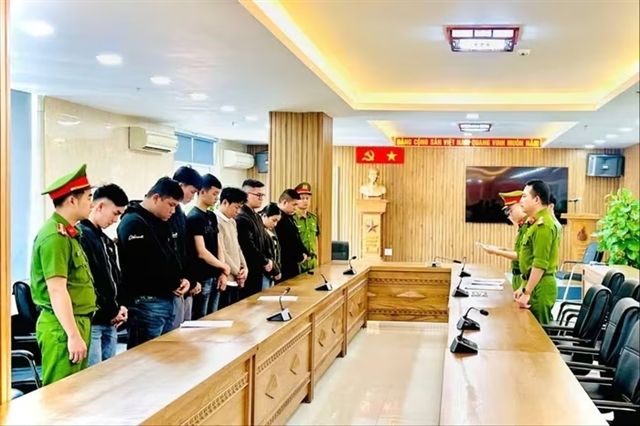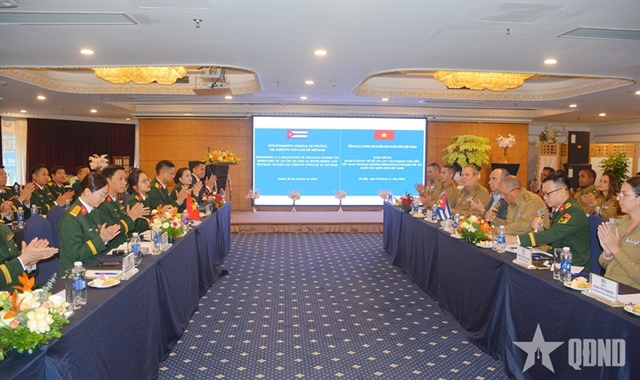 Opinion
Opinion

 |
| PARTNERSHIP: Prime Minister Phạm Minh Chính (2nd right) meets Jensen Huang (2nd left), founder and CEO of NVIDIA Corporation (US), in Hà Nội on December, 5, 2024. The meeting included the signing of a cooperation agreement between the Government and NVIDIA. — VNA/VNS Photo |
Thu Vân
On September 2, 2024, Việt Nam’s National Day, a month after being elected General Secretary of the Communist Party of Việt Nam (CPV), Tô Lâm stated that Việt Nam would boldly step into a new era, with unwavering determination and a commitment to making greater contributions to maintaining peace, stability and sustainable development.
That statement underscored the nation’s resolve to achieve its development goals, marking a historic turning point and opening a new chapter of progress for the country. The message resonated widely, gaining support from the Vietnamese people and drawing international attention.
Việt Nam aims to transform into a modern, industrialised, upper-middle-income country by 2030, with the ultimate goal of achieving high-income status by 2045. The 14th National Congress of the CPV slated to open in January 2026 is set to provide the foundation for this ambitious new era, reflecting the country’s determination to elevate its global standing and national prosperity.
General Secretary Lâm has outlined seven strategic priorities to guide Việt Nam towards these goals. Central to this vision is innovating the Party’s leadership methods to ensure governance remains effective and forward-thinking. Strengthening Party-building efforts and refining the rule of law are also pivotal to fostering a stable and just society.
 |
| BONDING: General Secretary of the Communist Party of Việt Nam Central Committee and State President Tô Lâm meets with Vietnamese intellectuals in Houston, Texas, in September 2024, during his official visit to the United States. — VNA/VNS Photo |
Streamlining organisational structures is crucial for enhancing efficiency and effectiveness across all sectors. Driving digital transformation and technological development will further accelerate progress and modernisation. Efforts to combat waste and resource mismanagement are equally critical, ensuring sustainability and accountability.
Equally significant is reforming personnel policies and improving human resource management to build a skilled and dynamic workforce capable of meeting the demands of the new era. Finally, implementing robust economic strategies will help Việt Nam avoid the middle-income trap, setting the stage for sustained and inclusive growth.
Bridging vision and action
As Việt Nam embarks on its journey into a new era of development, expert perspectives highlight the profound significance of the nation’s vision and strategic direction under General Secretary Lâm’s leadership. These insights underscore the collective determination to achieve ambitious goals while addressing the challenges of modernisation and innovation.
 |
| POLICY INJECTION: Resolution 57 marks a significant milestone in the development of science and technology, innovation, and national digital transformation, allowing the pilot of new initiatives, even those that involve risks, venture investments, or potential delays in scientific research. VNA/VNS Photo |
Nguyễn Văn Đáng, PhD, of the Hồ Chí Minh National Academy of Politics explained why the term “the era of the nation's rise” and the associated political determination have been so enthusiastically received by the public.
“It is because we have proactively identified a clear timeframe for future achievements, reflecting the Party and State leadership's resolute commitment to significant socioeconomic transformations. Over 40 years of reforms, Việt Nam has made substantial strides in economics, politics, society, foreign relations, and international trade. These achievements have fostered a collective mindset of urgency and aspiration among the Vietnamese people to elevate the nation to new heights. The public warmly welcomes General Secretary Lâm’s vision and determination to transform Việt Nam into a high-income developed nation by the mid-21st century, aspiring to join the ranks of the world's leading countries,” Đáng said.
Dr Trần Đình Thiên, an economist, former director of the Việt Nam Institute of Economics, said: "This new era is defined by extraordinary goals—achieving digital transformation, intelligence-driven development, and green growth, which are among humanity's highest aspirations.
“These ambitious targets demand a truly exceptional era of action.”
For his part, Professor Vũ Minh Khương at the Lee Kuan Yew School of Public Policy in Singapore praised General Secretary Lâm’s message as both strategic and groundbreaking.
“Its strategic aspect lies in the courageous decision to propel the nation forward to an unprecedented level in the coming years. Clearly, the choices we make today will determine where we stand tomorrow. Leadership decisions are critical—they will decide whether a nation rises or falls, how fast it rises, and how far it progresses. Poor decisions lead to decline, often rapid and far-reaching. This truth is evident in the lessons of human history as well as in our recent realities,” Khương said.
Khương highlighted three remarkable attributes of the message’s groundbreaking nature: firstly, its ability to resonate deeply with human emotions, stirring a collective national spirit; secondly, its alignment with the trends of the modern era; and thirdly, its emphasis on institutional choice, which creates a synergy of internal strength—a self-reinforcing power that grows stronger with every step forward.
"General Secretary Tô Lâm’s message is exceptionally clear. Its distinctiveness lies not only in its content but also in the actions that follow. As a Vietnamese living abroad, I feel an immense sense of pride and renewed faith in our nation’s future,” Khương said.
According to Carl Thayer, an expert in Southeast Asian security and diplomacy, Việt Nam holds numerous advantages to forge ahead with determination.
“Việt Nam’s advantages are manifold. It has a large population base, a global diaspora, untapped abundant natural resources, a strategic location in the heart of an economically vibrant region adjacent to global shipping lanes, a culture that prizes education, political stability, a substantial network of strategic partners, leadership with a long-term vision and determination to innovate, and growing prestige and influence in the international community,” he noted.
However, challenges remain on the horizon.
“Việt Nam must successfully implement an institutional revolution and streamline its political system to attract increased foreign investment, which is critical to propelling the country into the digital age. This will demand significant efforts to develop human resources. Additionally, Việt Nam must prepare to mitigate the adverse effects of a potential US-China trade war, which could be exacerbated by Donald Trump’s threat to raise tariffs on Chinese exports to the US or impose punitive tariffs on Việt Nam,” he explained.
Institutional reform: The core of development
Thayer’s assessment aligns with the views of General Secretary Lâm, who has identified institutional reform as the most pressing priority for Việt Nam’s development. Speaking at a national conference in December 2024, General Secretary Lâm described the restructuring of Việt Nam’s political system as a “revolution” in governance. This ambitious overhaul involves merging redundant agencies, reallocating responsibilities, and improving operational efficiency to enhance the effectiveness of state apparatus and governance.
By streamlining Party, State, and socio-political organisations, Việt Nam aims to eliminate bureaucratic inefficiencies and foster innovation.
“This restructuring is essential for the nation’s rising era,” said Gen Sec Lâm. “We must act with decisiveness and urgency.”
Within just a few months of 2024, the groundwork for this systemic overhaul has been laid and implementation has commenced.
Taking August 3, 2024 as a starting point—when Lâm was elected as General Secretary of the CPV Central Committee—it took just over a month for him to first address the initiative during the closing remarks of the 10th Plenum of the 13th Central Committee on 20 September. He stated: "We will continue to focus on building and streamlining the organisational structure of the Party, the National Assembly, the Government, the Motherland Front, and socio-political organisations to operate effectively and efficiently. Among these, the organisational apparatus of the Party must become the nucleus of intellectual leadership, serving as the 'general staff' and the vanguard leading the State agencies."
By 5 November, in an article titled "Streamlined, Strong, Efficient, and Effective", General Secretary Lâm explored in depth the inefficiencies within Việt Nam's political system. For the first time, he characterised the restructuring initiative as a "revolution", stating: "The confluence of strategic opportunities after 40 years of reform presents a historic chance for the nation to enter an era of development and the rising era of the Vietnamese nation. This also necessitates an urgent and decisive revolution to build a truly streamlined, effective, and efficient political system that meets the demands of the new revolutionary phase."
This sentiment was reinforced in his closing speech at the 13th Central Committee’s plenum on 25 November, where he reiterated the utmost political determination: "Implementing the Central Committee’s directives on reviewing Resolution 18 of the Central Committee and optimising the organisational apparatus of the political system is of paramount importance. This is a revolutionary endeavour to streamline the organisational structure of our political system for effective and efficient operation."
What distinguishes this restructuring revolution is its decisiveness. The Central Committee’s plan leaves no institution untouched. From smaller entities such as organisational magazines to major bodies like ministries, National Assembly committees, and government agencies, all are under review for potential reorganisation. Specific proposals include reducing the number of government ministries by five and eliminating two subordinate agencies, while the National Assembly will see four of its committees merged or restructured.
Although the precise figures for staffing reductions and cost savings have yet to be calculated, the expected savings are anticipated to be substantial. More importantly, this reorganisation seeks to enhance the operational efficiency of Việt Nam’s entire political system. By unblocking critical bottlenecks that have hindered national development, it aims to catalyse the momentum of the rising era.
Digital transformation and technological innovation
Digital transformation and technological innovation lie at the heart of Việt Nam's strategy for its emerging era. On 22 December 2024, the Politburo issued Resolution 57, marking a significant milestone in the development of science and technology, innovation, and national digital transformation.
 |
| NEW ERA: Việt Nam aims to boldly step into a new era of sustainable development, transforming into a modern, industrialised, upper-middle-income country by 2030 and achieving high-income status by 2045. VNA/VNS Photo |
Resolution 57 sets an ambitious target for Việt Nam to rank among the top three Southeast Asian nations in AI research, digital competitiveness, and e-government by 2030. It provides a detailed roadmap for enhancing labour productivity and embedding innovation within the country's socio-economic framework.
The resolution tackles key policy and regulatory challenges in the science and technology sector by introducing a progressive approach that prioritises effective governance while encouraging innovation. It represents a clear shift from the previous restrictive mindset that favoured prohibition over control.
This resolution authorises the Politburo to pilot new initiatives, even those that involve risks, venture investments, or potential delays in scientific research. It supports research institutions in establishing mechanisms that allow organisations and scientists to commercialise their research findings by starting and managing businesses. Funding for scientific and technological research will be allocated through a fund-based model, supported by dedicated science and technology development funds.
Additionally, the resolution offers preferential policies that benefit businesses, particularly small and medium-sized enterprises (SMEs), encouraging them to invest in digital transformation, scientific research, and technological innovation. These initiatives are designed to enhance operational efficiency, increase competitiveness, and promote a culture of innovation across all sectors.
Former Minister of Science and Technology Nguyễn Quân said that the implementation of Resolution 57 would significantly enhance Việt Nam's scientific and technological capacity, playing a crucial role in the nation's transformation during this dynamic era.
Vice Chairman Nguyễn Phương Tuấn of the NA’s Committee for Science-Technology and Environment said that Resolution 57 aims to remove all barriers, not just legal ones, that hinder businesses' participation in scientific research, technological development, and innovation. The resolution positions "people and businesses as central factors, driving forces, and primary resources, with scientists as key facilitators".
Prior to the adoption of Resolution 57, on 5 December 2024, NVIDIA signed a Memorandum of Understanding (MoU) with the Ministry of Planning and Investment to establish two state-of-the-art AI centres in Việt Nam: NVIDIA’s third global AI research hub—the Việt Nam Research and Development Centre (VRDC)—and an AI Data Centre.
The Vietnam AI Research and Development Centre (VRDC) and the AI Data Centre will serve as key platforms for NVIDIA and its domestic partners to advance the research, development, and deployment of cutting-edge AI technologies. These centres are expected to play a crucial role in supporting AI research initiatives, developing AI applications, fostering innovation and entrepreneurship, and creating job opportunities for Việt Nam's talent pool.
Driving towards high-income status
Nguyễn Văn Đáng, PhD, of the Hồ Chí Minh National Academy of Politics highlighted Việt Nam's remarkable transformation over nearly 40 years of economic reform. The country transitioned from being a low-income nation to joining the ranks of middle-income countries in 2008-2009. With GDP per capita rising from less than US$200 in the 1990s to approximately $4,300 today, this represents a convincing testament to Việt Nam’s economic progress.
In international trade, Việt Nam has shifted from near-isolation to becoming a proactive global participant. It has signed free trade agreements with nearly 20 countries, engaged with major international organisations, and established comprehensive strategic partnerships with global superpowers. This deep integration underscores Việt Nam’s proactive and successful engagement with the global economy.
International experts are optimistic about Việt Nam’s socioeconomic outlook for 2025. According to the UK-based Centre for Economics and Business Research (CEBR), Việt Nam’s GDP per capita is expected to reach $4,783, bringing the country closer to achieving upper-middle-income status. This would place Việt Nam 124th globally in per capita income, reflecting notable progress in enhancing living standards.
Similarly, both the World Bank and the Asian Development Bank (ADB) project positive growth for Việt Nam in 2025, with GDP growth estimates of 6.5 and 6.6 per cent, respectively, driven by a robust recovery in manufacturing, trade, and fiscal policies.
Looking ahead to 2045, the World Bank’s report "Vietnam 2045: Trading up in a Changing World – Pathways to a High-Income Future" emphasises the need for Việt Nam to shift from labour-intensive, low-value manufacturing to high-skill, technology-driven industries. This transformation necessitates investments in technology, workforce skills, and innovation to maintain competitiveness in a changing global trade environment.
Recommendations include reducing non-tariff trade barriers, enhancing education and vocational training for high-tech industries, strengthening connections between domestic firms and global value chains, and ensuring low-carbon, climate-resilient exports.
Andrea Coppola, World Bank Lead Country Economist for Việt Nam, acknowledged the country's progress in institutional reform but stressed the need for further adjustments to achieve its high-income ambitions.
Coppola praised Việt Nam's consensus-based decision-making system for avoiding hasty decisions but noted its tendency to delay necessary reforms. He called for a shift from a "prohibition" mindset to one of "facilitation", reducing unnecessary regulations to foster creativity and efficiency. This flexible approach, he argued, would empower civil servants to innovate and improve state efficiency.
Coppola also highlighted the importance of restructuring government operations to address inefficiencies, including duplicative roles and misaligned incentives. He recognised Việt Nam’s efforts in revising its Public Investment Law as a step forward but recommended additional improvements in budgeting processes and legal frameworks.
With sustained reforms and strategic investments, Việt Nam is well-positioned to achieve its goal of becoming a high-income economy by 2045 while navigating a dynamic global trade landscape. VNS




